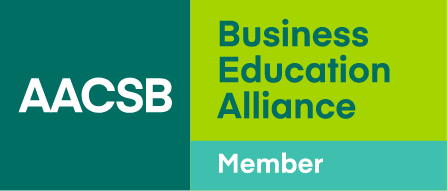Improv at the B-School
Through applied improvisation techniques, business students learn innovation, adaptability, and collaboration.
Sarah Noll Wilson draws her arm back to gently toss me a beanbag. She’s watched by 40 baffled business students who, just moments before, had been discussing the concepts of teamwork and collaboration. When she lobs the beanbag in my direction, I shout, “No!” and bat it away, narrowly missing a pitcher of water on a table nearby. The students laugh—and wait for the explanation.
“We’ve just talked about the concept of ‘Yes, and’ versus ‘Yes, but,’” says Noll Wilson, a leadership coach and consultant. “And when you have a ‘Yes, but’ person on your team, doesn’t it feel like that? You just keep tossing him ideas, and he slaps them away.”
This demonstration is a bit of silliness, but Noll Wilson and I are convinced that it will help students remember the lesson on collaboration we have just delivered. Like Noll Wilson, I’m not a typical business teacher—I’m a mathematics professor, local politician, and comedy show emcee. Together, we’ve been hired to make deep changes in the thinking and habits of students at the College of Business Administration (CBA) of the University of Northern Iowa (UNI) in Cedar Falls. And we think our tactics are working.
Problem and Solution
The CBA prides itself on providing a “job-ready academic experience at a demanding intellectual level,” and even though I teach in a different college at the university, I’ve always been proud of our university’s business program. But ten years ago, the CBA received disturbing feedback: During meetings with interns from larger institutions, UNI student interns tended to hang back and speak last, if at all. On the other hand, when they did contribute, they were likely to be correct and insightful.
Our dean had been hearing similar stories from successful alumni. They reported feeling academically prepared for their jobs as young associates, but also that they lacked the professional savvy that could have propelled their careers faster in their early years. Think about that—students left UNI feeling well-prepared, but they were hesitant to show it!
The college moved quickly to change the dynamic. A student on the President’s Council had taken her senior capstone course with Gretta Berghammer of UNI’s theater department, and this student told the dean that she had learned many skills in that course that she could apply in her career. So, the business school asked Berghammer to create a series of workshops that would help business students develop and practice skills such as boldness, adaptability, creativity, and collaboration. The dean also consulted other student leaders from the President’s Council for input on development of the program.
As a math professor, I seemed an unlikely candidate to participate in the program, but I had been doing improv for over a decade. I had created and was directing UNI’s comedy troupe, and I also had been running improvisation-based workshops for training people in sexual harassment awareness and other situations. Berghammer approached both Noll Wilson and me to ask if we would like to become involved in the project.
Together, we create improv workshops, which we continue to refine based on feedback from students and administrators. Our goal is to keep the workshops current—and to make the effects both significant and long-lasting.
While UNI was an early adopter of the “applied improvisation” method, I’ve seen the concept take hold throughout the business community in the past ten years. Organizations such as Second City in Chicago, the Alan Alda Center for Communicating Science at Stony Brook University in New York, and hundreds of consulting firms have worked with businesses to build skills that historically have been neglected or actively discouraged in business programs. The Applied Improvisation Network, which was founded in 2002, has over 5,000 members and enjoys growing attendance every year at its international conference. As all these advocates know, applied improvisation can be used to develop a broad range of abilities—from creative thinking to collaboration—in ways that are both memorable and fun.
A Particular Set of Skills
At UNI, we use our applied improvisation workshops to give students a chance to learn about and practice a range of skills. The workshops span two 75-minute sessions, or three hours total. They are required courses for business students and take place over two consecutive sessions of the school’s Professional Readiness Program. By the time students are done with the workshops, we hope they will have expanded their abilities in three key areas:
Boldness and innovation. Innovation is no longer the sole province of the “creatives” in a company. Business leaders have told us that the next important new idea could come from anyone in their organizations. And, as we discovered with our shy interns, even creative thinkers must be willing to speak up boldly.
Adaptability. The rate of change is accelerating every year. Well-known, well-established companies such as Radio Shack, Staples, and Sears are struggling or failing. At the same time, new disruptors are showing up every day. It is hard to imagine that prior to 2007, Tesla, Uber, the iPhone, and Netflix streaming did not exist. It’s impossible to predict what will come next, so business leaders must be ready for whatever happens.
Collaboration. Cooperation is essential. Employers are looking for new hires who are able to work in teams effectively and who can thrive in working environments that go beyond merely being nontoxic to being supportive and dynamic.
At UNI, we want our students to recognize that they must cultivate their abilities in all three of these areas. Furthermore, we want them to develop the mindset that they should not only continue practicing these skills after they graduate, but also be willing to extend their knowledge whenever they have the opportunity. To that end, we try many different activities to engage students, and we constantly tweak class offerings. Here are just a few examples of what we do.
Connect the Dots
To help students master boldness and innovation, we break the topic into three areas: risk taking, going beyond mental defaults, and understanding the power of play. Here, I’ll just focus on the two-part strategy Noll Wilson and I use to teach students how to go beyond mental defaults.
We pair the students up, have them extend their right hands, curl their fingers, put their thumbs up, then link their curled fingers in this position:
Noll Wilson tells them, “Your goal is to get your partner to put his or her thumb down.” Invariably, even before the instructions are finished, some students will shout, “Thumb wrestling!” After a short period of time while they engage in the activity, we ask how many have succeeded in getting their partners to lower their thumbs. About half raise their hands. When we ask how many played thumb war, almost all of them raise their hands.
That’s when we point out that no part of the original directions told them to thumb wrestle. We then brainstorm other ways they could have achieved the stated goal. Common answers include asking partners to put their thumbs down, offering bribes, putting down their own thumbs first, inverting their hands so both thumbs are down, and committing various acts of violence. At this point we discuss mental defaults, which are assumptions we make that are not part of a problem and that might inhibit us from coming up with innovative solutions.
Then we move on to part two, although we don’t tell students that it is part of the same exercise. I have participants draw an array of 3 x 3 dots (see Figure 1 below). Their new assignment is to try to connect these dots by drawing four straight lines without lifting their pens from the paper. When they become frustrated, we often have to assure them that there is an answer and it won’t feel like a cheat. After time has passed, I reveal the solution (see Figure 2).

Then I ask, “What made this problem hard? Why did you get stuck?” Students realize that they had put an imaginary constraint on their answers: They hadn’t wanted to extend the lines beyond the border of their dots. I tell them, “This just shows you how hard it is to think outside the box, even when the box literally does not exist.”
I also point out that even though the instructors had just discussed mental defaults, students still imposed defaults on this problem. We wrap up by assuring them that they shouldn’t be embarrassed, because this demonstration just proves how pernicious these defaults are. Even when we’ve just been warned not to limit ourselves, we still impose restrictions on our thinking.
We then note that “dots” have thickness, and thus we can do the problem in three lines (see Figure 3).
Finally, we ask students if the dots can all be connected with one line. By this point, they are determined to throw off all limits. They will cheerfully suggest things like using an extremely thick marker, or folding the paper so all lines are overlaid.
Notice that while this exercise includes some lecture and storytelling, it is mostly experiential. The students feel what it is like to impose mental defaults, to notice them, and to learn how to go beyond them. In everything we do, our goal is to have students “feel what it is like.” We then reinforce the experience with brief lectures and stories.
Explode the Myth
To train students in adaptability, we use an activity that takes less than ten minutes. But in that brief period of time, we dispel a myth dramatically and permanently—and make a huge impact on students.
We begin by tricking students with a cliché. I say, “Agree or disagree with this statement: People fear change.” Invariably, almost all students agree, as they’ve been hearing this statement ever since they’ve first started to think about consumers.
Then Noll Wilson asks if there’s anyone in the room who has no cash on them. A few students raise their hands, and Noll Wilson gives one of them a $5 bill. We say, “That was a change. Did it frighten you?”
This leads to a discussion about which kinds of change we fear and which ones we don’t. The conclusion is that people don’t fear change; they fear loss. We follow that up with a discussion about how we can move to a mindset that focuses on the potential gains that are brought about by change, not on the losses. We also discuss with students the fact that, in this changing world, adaptability is crucial for success.
Emphasize the ‘And’
For our study of collaboration, we focus on promoting successful teamwork through careful listening and constructive responding. We explain that careful listening can be broken down into being focused and displaying curiosity, while constructive responding consists of “plussing” and supporting. Let me describe how we teach plussing, starting with a definition of the word.
Plussing is the notion of taking an idea, building on it, and then tossing it to someone else so the process can continue. It’s a basic tenet of improvisation, where the concept is often referred to as “Yes, and.” “Yes, that’s a great idea, and what if we did this, too?” The computer animation film company Pixar uses plussing as a major part of its corporate strategy.
Students often take “Yes, and” to mean they must agree with everything. But that’s not true. The notion behind plussing isn’t so much to agree with a suggestion as to say, “I hear your idea, and I am willing to play with it for a while.”
For the classroom activity, we pair students and give them the following assignment. “You are co-workers whose company has had an outstanding year, and your reward is a company trip. The two of you get to plan the trip, with one stipulation. After the first sentence, everything you say must begin with the phrase, ‘Yes, but.’”
After students have spent a few minutes in this exercise, we ask them to describe the trips they’ve envisioned. Their energy is usually low at this point; they haven’t gotten far in their plans, and they report feeling frustrated and blocked.
We have them try again, but with one seemingly minor change. Instead of using “Yes, but” to start every sentence, they must begin with “Yes, and.” After about 15 seconds, the entire mood of the room changes. It seems as if the sun has come in through the window. The students grow animated and begin talking faster. Now when Noll Wilson and I ask about their company trips, we hear about exotic locations and fun, creative excursions.
We ask how it feels different to say “Yes, and” instead of “Yes, but.” And then Noll Wilson picks up a beanbag.
Final Debrief
Noll Wilson and I end the workshop by asking students to answer three questions: What surprised you? What’s one thing you won’t forget? What’s one thing you can use? The ensuing discussion is different every time, but students always have plenty of answers as they relate to the material on a personal level.
Evaluations for the workshop are enthusiastically positive. Many students have told us they’ve had major “aha!” moments during the exercises; others have shared with us how one activity or another has proved relevant to issues they’ve been struggling with in their lives. In the future, we’d like to do some long-term tracking to see what students think of the workshop’s usefulness several years after they’ve graduated.
But for now, we hope we know how they’ll react when someone throws them a “beanbag” at work. They’ll catch it, add something to it—and throw it back.
Doug Shaw serves as an improvisational coach for the Professional Readiness Program in the College of Business Administration. Also contributing to this article were Sarah Noll Wilson, leadership coach and consultant and CEO of Sarah Noll Wilson Inc.; Laurel Shaw, a web designer and editor in Cedar Falls; and Sara Kies, marketing and communications manager for the University of Northern Iowa.





